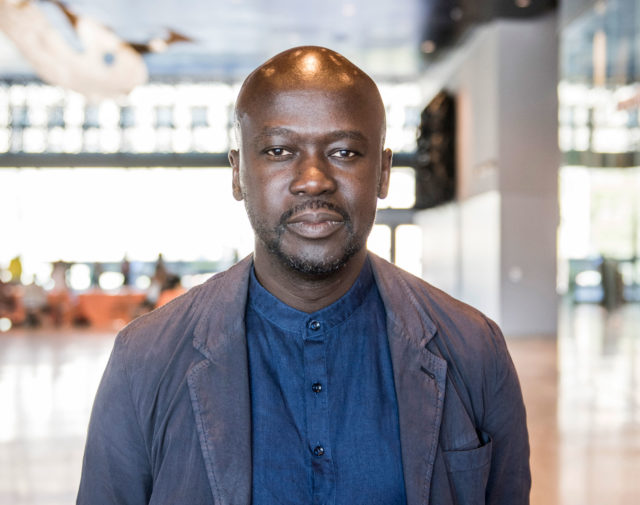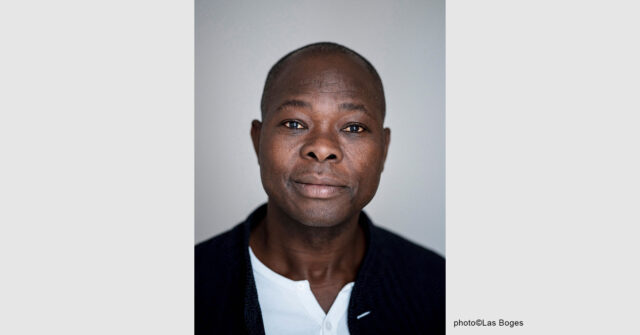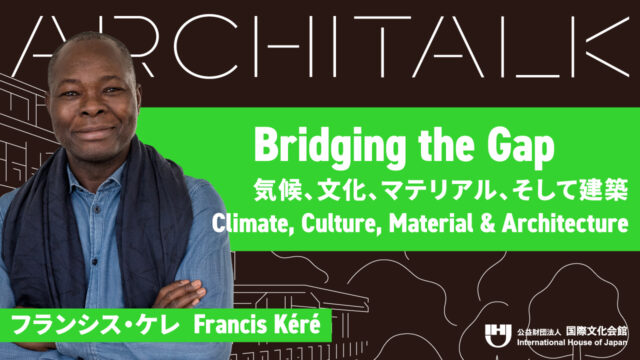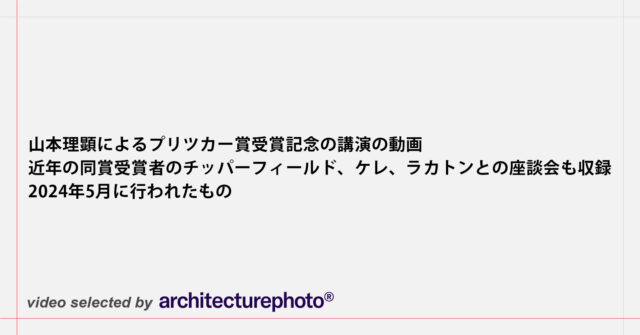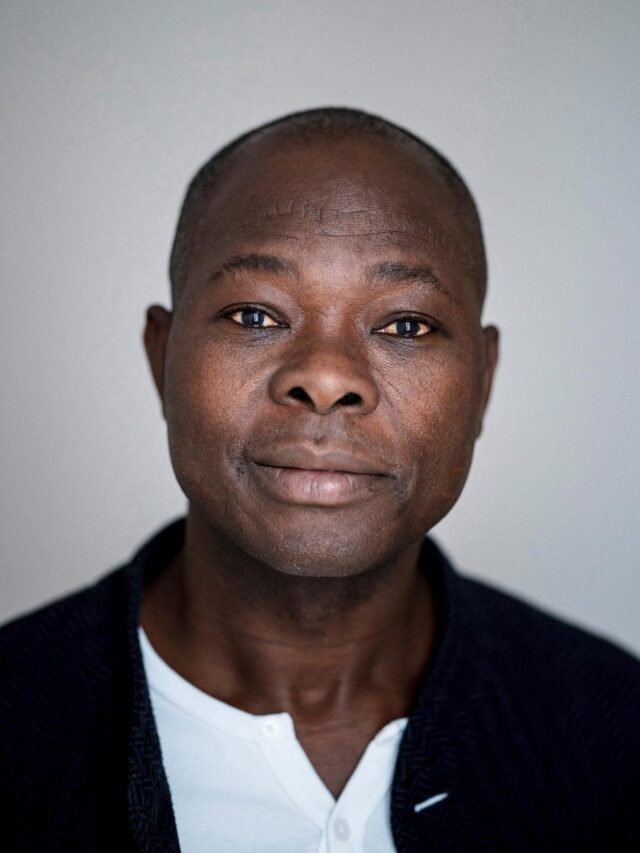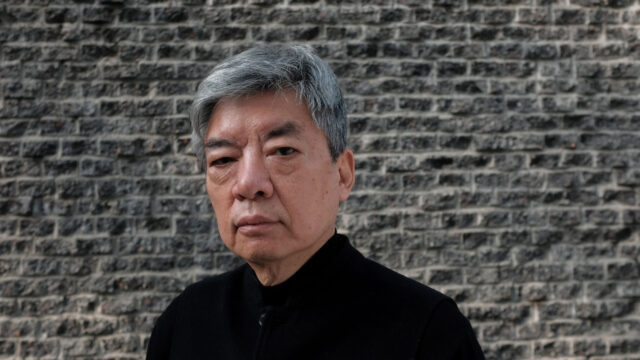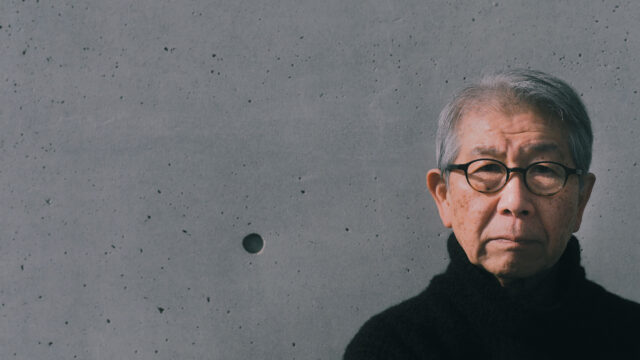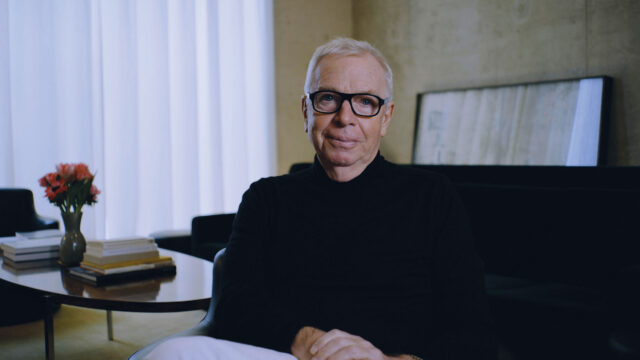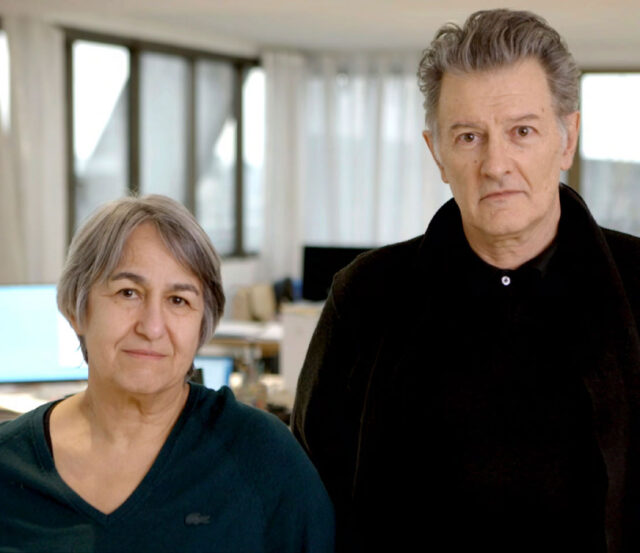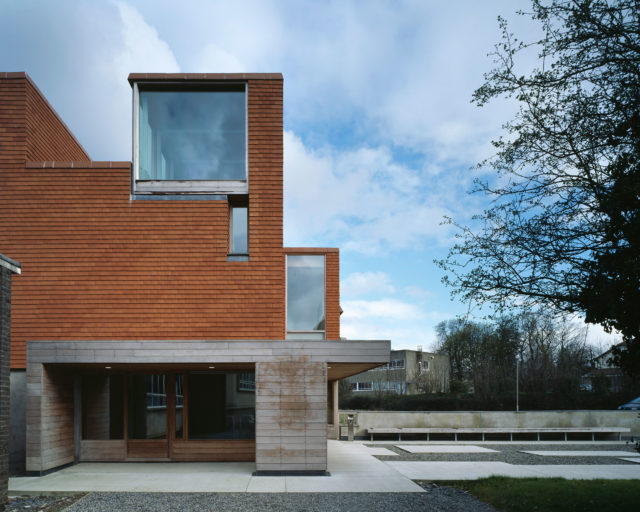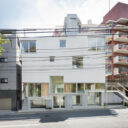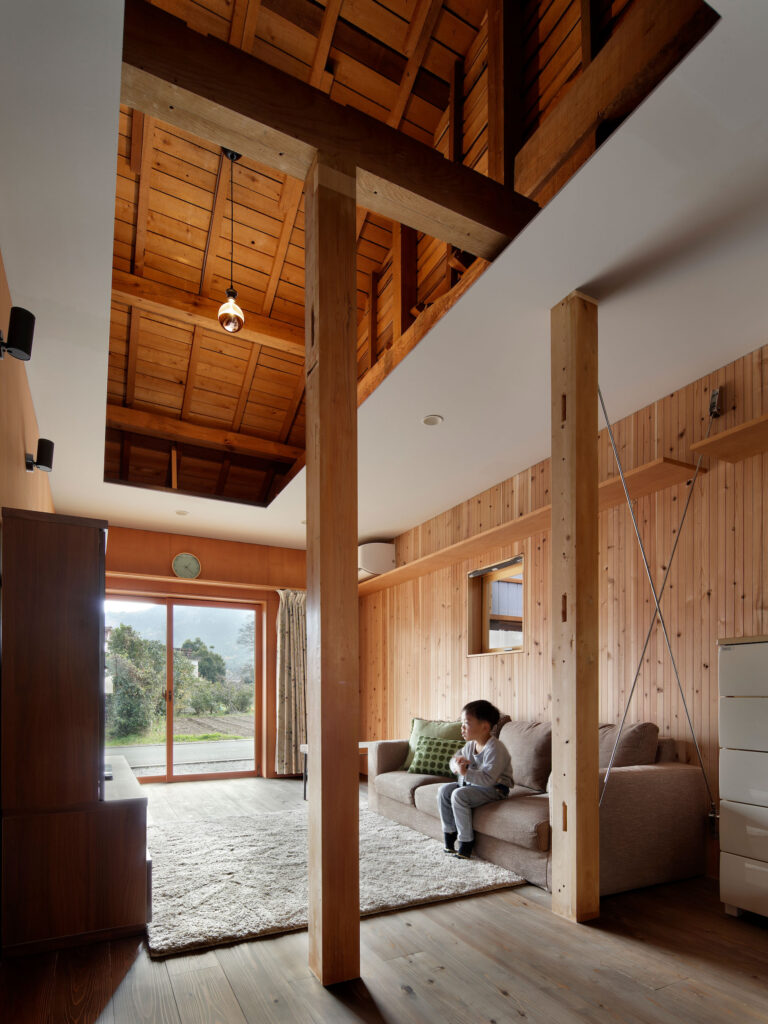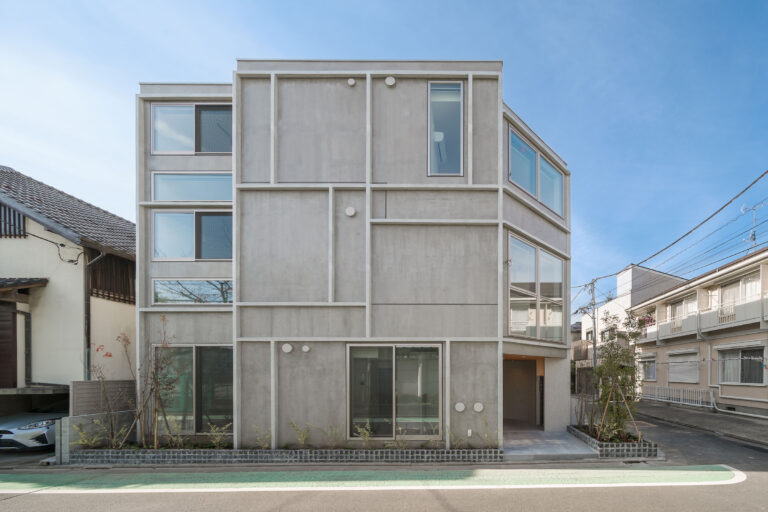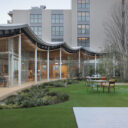
SHARE 2022年のプリツカー賞を、フランシス・ケレが受賞。アフリカのブルキナファソ出身で、故郷での学校建築や議会も手掛ける建築家。その代表作と業績を紹介




2022年のプリツカー賞を、フランシス・ケレが受賞しました。アフリカのブルキナファソ出身の建築家で、ベルリンで建築を学び、ブルキナファソ・ケニア・モザンビーク等で、学校や医療施設等を手掛けています。リリーステキストに加え、審査講評のコメント、ケレの経歴、その建築を紹介する動画も掲載します。過去の受賞者のリストはこちらのページで閲覧することができます。
以下にリリーステキストの翻訳と主要作品を掲載します
ディエベド・フランシス・ケレ、2022年プリツカー建築賞を受賞
建築家、教育者、社会活動家であるディエベド・フランシス・ケレ氏が、2022年度のプリツカー建築賞受賞者に選ばれたと、建築界の最高の栄誉とされるこの賞を主催するハイアット財団会長のトム・プリツカーが発表しました。
「私は、パラダイムを変え、人々に夢を与え、リスクを負わせることを望んでいます。金持ちだからといって、材料を無駄にする必要はありません。貧乏だからといって、質の高いものをつくろうとしないのではないのです」とケレは言います。「誰にでも品質があり、誰にでも贅沢があり、誰にでも快適がある。私たちは互いにつながっており、気候や民主主義、欠乏における懸念は、私たち全員にとっての懸念なのです」
ブルキナファソのガンドで生まれ、ドイツのベルリンを拠点に活動する建築家、フランシス・ケレは、建築というプロセスを通じてコミュニティに力を与え、変容させる存在です。社会正義と社会貢献へのコミットメント、そして自然の風土とつながり、それに応えるために地元の素材を賢く使うことを通して、彼は建築やインフラが存在しない、制約と逆境に満ちた限界的な国々で活動しているのです。現代的な学校施設、医療施設、専門家住宅、市民建物、公共スペースなどを、しばしば資源が脆弱で親睦が不可欠な土地に建設し、彼の作品の表現は建物自体の価値を超えています。
「フランシス・ケレは、地球とそこに住む人々にとって持続可能な建築を、極端に乏しい土地で開拓しているのです。彼は建築家であると同時に奉仕者であり、時に忘れ去られがちなこの地域の無数の市民の生活と経験を向上させているのです」とプリツカーはコメントしています。「美しさ、謙虚さ、大胆さ、発明を示す建築物を通して、そして彼の建築と身振りの誠実さによって、ケレはこの賞の使命を静々と守っているのです」
以下の写真はクリックで拡大します


ガンド小学校(2001年、ブルキナファソ、ガンド)は、ケレのイデオロギーの基礎を築きました。それは、コミュニティとともに、コミュニティのために泉を作り、必要なニーズを満たし、社会の不平等を是正するというものでした。限られた資源で猛暑や劣悪な照明環境に対応できる物理的かつ現代的な施設の設計と、地域社会からの不穏な空気を克服する社会的な解決策の2つが必要だったのです。彼は、国際的な資金調達を行う一方で、構想から職業訓練まで、地元住民のために必ず機会を作りました。土着の粘土をセメントで固め、生物気候学的な熱質量のあるレンガを形成し、内部の冷気を保持しながら、レンガの天井と大きく張り出した高さのある屋根から熱を逃がし、結果として空調という機械を介さない換気ができるようにしたのです。このプロジェクトの成功により、同校の生徒数は120人から700人に増え、教員住宅(2004年、ブルキナファソ、ガンド)、増築(2008年、ブルキナファソ、ガンド)、図書館(2019年、ブルキナファソ、ガンド)へと発展していったのです。
2022年の審査員引用文には、こう記されています「彼は、建築とは対象ではなく目的であり、製品ではなくプロセスであることを、内側から知っています。フランシス・ケレの全作品は、場所に根ざした物質性の力を私たちに教えてくれます。彼の建築は、コミュニティのために、コミュニティとともにあり、その作り方、素材、プログラム、そしてユニークなキャラクターにおいて、直接コミュニティのものなのです」
以下の写真はクリックで拡大します






小中学校における彼の作品のインパクトは、多くの教育機関の設立のきっかけとなり、それぞれが生物気候環境に対する感受性と地域特有の持続可能性を示し、多くの世代に影響を与えました。情報通信技術のキャンパスであるスタートアップ・ライオンズ・キャンパス(2021年、ケニア・トゥルカナ)では、地元の採石場と積層タワーをパッシブ冷却に使用し、技術機器を保護するために必要な空調を最小限に抑えています。ブルキナ工科大学(2020年、ブルキナファソ、クドゥグ)は、建築プロセスを加速させるために現場打ちされた冷却用粘土壁で構成されています。また、雨水は地下に集められ、敷地内のマンゴー農園の灌漑用水として利用されています。
以下の写真はクリックで拡大します








ケレに対する国民の信頼と支持は、この建築家の最も重要で野心的なプロジェクトの一つである、ブルキナファソ国民議会(ブルキナファソ、ワガドゥグ)を促しました。依頼をされましたが、現在のような不透明な時代では未完成のままです。2014年のブルキナベの反乱で以前の建物が破壊された後、建築家は階段と格子のピラミッド型の建物を設計し、内部には127人の集会所を収容し、外部には非公式の集会を奨励するようにしました。物理的にも比喩的にも新しい景色を可能にするこの建物は、より大きなマスタープランの一部であり、固有の植物、展示スペース、中庭、そして旧政権への抗議で命を落とした人々の記念碑を含むことが想定されています。
ケレの作品には、光に関する詩的な表現が一貫して見られます。太陽の光は、建物、中庭、中間的なスペースに差し込み、真昼の厳しい条件を克服して、静寂や集いの場を提供します。ガンド小学校の図書館のコンクリート屋根は、伝統的な土壺をグリッド状に並べ、それを抜き取ると、熱を逃がす開口部ができ、円形の自然光が室内にとどまり、照らされます。ユーカリ材で作られたファサードが楕円形の建物を囲み、垂直方向に光を放つ柔軟な屋外空間を作り出しています。ベンガ・リバーサイド・スクール(2018年、モザンビーク、テテ)は、小さな空洞が繰り返されるパターンの壁を備え、光と透明性によって生徒の信頼感を呼び起こすことができるようになっています。保健社会福祉センター(2014年、ブルキナファソ、ラオンゴ)の壁は、さまざまな高さの枠付き窓のパターンで飾られ、立っている医師から座っている訪問者、横たわる患者まで、すべての人に絵になる風景の景色を提供します。
危機的状況にある世界、変化する価値観や世代の中で、彼は、これまでも、そしてこれからも間違いなく建築の礎となるもの、すなわち、彼自身が思いやりと誇りをもって語ることのできるコミュニティの感覚と物語の質を思い出させてくれます。建築が継続的かつ永続的な幸福と喜びの源となり得ることを、彼は物語として提供しているのです。
以下の写真はクリックで拡大します







ケレのデザインには象徴性があり、アフリカ以外の作品には、ガンドでの生い立ちや体験が影響しています。西アフリカの伝統である、神聖な木の下で意見を交換し、物語を語り、祝い、組み立てるという習慣は、全体を通して繰り返されています。コーチェラ・バレー・ミュージック&アート・フェスティバルのサルバレー・ケ(2019年、米国カリフォルニア州)は、彼の母国語であるビッサ語で「祝祭の家」と訳され、彼の故郷で薬用効果があると崇められるバオバブの木をくり抜いた形を参照しています。サーペンタイン・パビリオン(2017年、イギリス・ロンドン)もまた、その中心的な形を木の形から取り、その切断されていながら曲線を描く壁は、彼の文化における強さを表す色、そしてより個人的には、建築家が子供の頃に着ていた青いブブーの衣服と同一視して、三角形のモジュールによって形成されています。屋根はアフリカの建築と同じように切り離されていますが、パビリオン内部では雨水が構造体の中心に流れ込み、世界中で経験する水不足が強調されています。現在建設中のベナン国民議会(ベナン共和国、ポルトノボ市)は、公園内にあり、パラバーツリーをモチーフにしています。議会は内部で行われますが、市民は建物の根元にある広大な木陰に集まることができます。
以下の写真はクリックで拡大します








ケレの作品の多くは、ベナン共和国、ブルキノファソ、マリ、トーゴ、ケニア、モザンビーク、トーゴ、スーダンなど、アフリカの国々で制作されています。また、デンマーク、ドイツ、イタリア、スイス、イギリス、アメリカでは、パヴィリオンやインスタレーションが制作されています。また、重要な作品として、ティペット・ライズ・アートセンターのザイレム(2019年、米国モンタナ州)、レオ医師住宅(2019年、ブルキナファソ、レオ)、リセ・ショージ中学校(2016年、ブルキナファソ、クドゥグ)、マリ国立公園(2010年、マリ、バマコ)、オペラ村(第1期、2010年、ブルキナファソ、ラオンゴ)などがあります。
ケレは、プロジェクトの開発、パートナーシップ、資金調達を通じてガンドの住民に貢献するため、1998年にケレ財団を、2005年にケレ・アーキテクチャーをドイツのベルリンに設立しました。ブルキナファソとドイツの二重国籍であり、プリツカー建築賞の第51回受賞者でもあります。
審査講評の翻訳
極端な物資不足の状況下で、建築はどのような役割を果たすのでしょうか。あらゆる困難を克服するための正しいアプローチとは何でしょうか。謙虚であるべきなのか、不利な状況に屈する危険を冒すべきなのか。それとも、控えめであることが適切であり、結果を出す唯一の方法なのでしょうか?変化を促すためには、野心的であるべきなのか。それとも、野心的であればあるほど、場違いであったり、単なる希望的観測に過ぎない建築になってしまったりするのでしょうか?
フランシス・ケレは、過去数十年にわたり、これらの問いに答えるための、素晴らしく、刺激的で、ゲームを変えるような方法を見つけ出してきました。彼の文化的な感性は、社会的・環境的な正義を実現するだけでなく、それがコミュニティにおける建築の正当性への道であることを認識し、そのプロセス全体を導いています。彼は、建築とは対象ではなく、目的であり、製品ではなく、プロセスであることを内部から知っているのです。
フランシス・ケレの作品全体は、場所に根ざした物質性の力を私たちに示しています。彼の建物は、コミュニティのために、コミュニティとともに作られ、その作り方、素材、プログラム、そしてユニークなキャラクターにおいて、直接コミュニティのものなのです。建築物は、その土地と、そこに住む人々と結びついているのです。気取ることなく存在感を示し、優しさによって形作られたインパクトを持っているのです。
ブルキナファソで、息子に教育を受けさせることに固執する両親のもとに生まれたフランシス・ケレは、ベルリンで建築を学びました。彼は何度も何度も、ある意味、原点に立ち返っています。彼は、ヨーロッパの建築の形成と仕事から学び、それを自国の伝統、ニーズ、習慣と結びつけてきたのです。世界有数の工科大学の教育資源を自分の国に持ち帰り、その資源が地域固有のノウハウ、文化、社会を向上させることを目指したのです。
ブルキナファソの国境を越えて多くの人々に模範を示し、後に教員寮と図書館を併設したガンドの小学校のように、彼は場所と伝統を尊重しながらも、提供できるものに変革をもたらす方法で、この任務を継続的に遂行してきたのです。そこでケレは、子どもたちが快適に学校に通えるようにするという一見シンプルな目標が、自分の建築プロジェクトの中心になければならないことを理解したのです。世界の大半の国にとってのサステナビリティとは、望ましくないエネルギー損失を防ぐことではなく、望ましくないエネルギー増加を防ぐことです。発展途上国の多くの人々にとって、問題は寒さよりもむしろ極度の暑さなのです。
二重屋根、サーマルマス、ウィンドタワー、間接照明、クロスベンチレーション、シェードチャンバー(従来の窓、ドア、柱の代わり)などは、彼の中心的な戦略となっただけでなく、実際に建築物の尊厳としての地位を獲得しているのです。ケレは、生まれ故郷の村に学校を完成させて以来、小さな村の市民生活だけでなく、やがて立法府の国家的な審議の場をも高めるために、地元の工芸品や技術を使って仕事をするという理念と方法を追求してきました。現在、ベナン国会議事堂のプロジェクトが進行中であり、ブルキナファソ国会議事堂のプロジェクトは、同国の政治情勢により一時的に中断しています。
フランシス・ケレの作品は、その本質と存在からして、その状況の果実です。建築家が最も多様なコンテクストでプロジェクトを構築する世界において、論争がないわけではありませんが、ケレは、草の根の経験、学術的品質、ローテク、ハイテク、真に洗練された多文化主義を非常に個人的なバランスで取り入れ、地域、国家、地方、グローバルな次元で議論に貢献します。例えば、サーペンタイン・パビリオンでは、世界中の建築の原初的なシンボルであり、長い間忘れられていた「木」を、世界共通の視覚的言語に、特に効果的な方法で翻訳することに成功しました。
彼は、繊細でボトムアップ的なアプローチを展開し、コミュニティの参加を受け入れました。同時に、トップダウンのプロセスも可能な限り取り入れ、高度な建築的解決策を追求しています。ローカルかつグローバルな視点は、美学や善意を超えて、伝統と現代を融合させます。
フランシス・ケレの作品はまた、何十億もの人々に適切な建物やインフラを提供するために努力する中で、持続不可能な生産と消費のパターンを変えるために必要な闘いを思い起こさせます。彼は、絶え間ない技術革新と構造物の使用・再利用という状況の中で、建築の永続性と耐久性の意味について根本的な疑問を投げかけているのです。同時に、現代的なヒューマニズムを展開し、歴史、伝統、精密さ、文書化されたルールと書かれていないルールに対する深い尊敬を融合させています。
フランシス・ケレは、その驚くべき業績と生涯に世界が注目し始めて以来、建築界における特異な存在として、その役割を担ってきました。彼は、今日の建築がいかにして世界中の人々の美的ニーズを反映し、そのニーズに応えることができるかを示してくれました。彼は、ローカリティが普遍的な可能性となることを教えてくれたのです。危機的状況にある世界、変化する価値観や世代の中で、彼は、これまでも、そしてこれからも間違いなく建築の礎となるもの、すなわち、彼自身が思いやりと誇りをもって語ることのできるコミュニティの感覚と物語の質を思い出させてくれるのです。このように彼は、建築が継続的かつ永続的な幸福と喜びの源となり得ることを物語ります。
フランシス・ケレは、彼の作品を通じて創造した、建築の領域を超えた贈り物に対して、2022年のプリツカー賞受賞者に指名されました。
審査員
アレハンドロ・アラヴェナ(議長
)
バリー・バーグドール
デボラ・バーク
スティーブン・ブレイヤー
アンドレ・アラーニャ・コレア・ド・ラーゴ
妹島和世
ワン・シュー
ベネデッタ・タグリアブエ
マヌエラ・ルカ・ダージオ(エグゼクティブディレクター)
フランシス・ケレの経歴
フランシス・ケレ(Diébédo Francis Kéré、1965年生まれ)は、世界で最も教育水準が低く貧しい国のひとつであるブルキナファソに生まれました。この国には建築物はおろか、清潔な飲料水や電気、インフラもありません。
「私は幼稚園がない地域で育ちましたが、そこでは地域社会が家族でした。みんなが面倒をみてくれて、村全体が遊び場でした。私の毎日は、食料と水の確保だけでなく、ただ一緒にいること、一緒に話すこと、一緒に家を建てることで満たされていました。祖母が座っていた部屋では、私たちは互いに身を寄せ合い、部屋の中で祖母の声が私たちを包み込み、もっと近くに来なさい、安全な場所を作りなさいと呼びかけていたのです。これが私の建築に対する最初の感覚でした」
ケレは村長の長男で、地域で最初に学校に通いましたが、ガンド市には学校がなかったため、7歳の時に家族と離れました。テンコドゴの小さな教室はセメントブロックでできており、換気も採光もままなりません。100人以上のクラスメートと一緒に何時間もその極端な気候に閉じ込められた彼は、いつか学校をより良いものにしようと心に誓ったのです。
「ブルキナファソの良い建築とは、座れる教室、フィルターを通した光、黒板や机の上など、使いたいように使える教室のことです。どうすれば、太陽からの熱を取り除き、光を有効活用できるのでしょうか。基本的な快適さを与える気候条件を整えることで、真の意味での教育、学習、感動を得ることができるのです」
1985年、彼は再び故郷を離れ、職業大工の奨学金を得てベルリンに渡り、昼は屋根や家具の製作を学び、夜は中等科に通うようになりました。1995年に奨学金を得てベルリン工科大学(ドイツ・ベルリン)に入学し、2004年に建築の上級学位を取得して卒業した。
ブルキナファソから遠く離れていても、ケレの心は故郷を離れることはありませんでした。1998年には「Schulbausteine für Gando e.V.」(「Gandoのための積み木」、後に「Kéré Foundation e.V.」と改名)を設立し、資金調達と子どもの快適な教室への権利の支持に取り組んでいます。彼の最初の建物であるガンド小学校(2001年、ブルキナファソ、ガンド)は、ガンドの人々によって、ガンドの人々のために建てられたものです。土着の材料と近代的なエンジニアリングを組み合わせた建築家の独創的な造形に導かれながら、地元の人々は構想から完成まで意見や労働力、資源を提供し、学校のほぼすべての部分を手作業で作り上げました。
ガンド小学校の成功により、2004年にアガ・カーン建築賞を受賞し、2005年にドイツ・ベルリンにケレ・アーキテクチャーを設立するきっかけとなりました。その後、ブルキナファソ、ケニア、モザンビーク、ウガンダの各地で、小学校、中学校、医療施設などを次々と実現させています。ケレ・アーキテクチャーがアフリカで手がけた建築物は、子どもたちへの教育、病人への医療提供だけでなく、大人たちへの職業機会の提供や職業技術の伝承など、コミュニティ全体の未来に貢献し安定させるという、飛躍的な成果を上げています。
ガンドに戻るたびに、ケレは目的にかなったアイデア、技術的知識、環境に対する理解、美的解決策を授けてきました。文化的感受性、関与のプロセス、献身を通じた人類への奉仕は、世界に対する寛容さの不変の例として証明されています。「私は、自分の仕事は私的な仕事であり、このコミュニティに対する義務であると考えていました。しかし、すべての人が時間をかけて、既存のものから調査することができます。人々の生活を向上させるために必要な品質を生み出すために、私たちは戦わなければなりません」
彼の仕事は、アフリカ諸国の校舎にとどまらず、デンマーク、ドイツ、イタリア、スイス、イギリス、アメリカでの仮設・恒久的な建造物へと広がっています。歴史的な国会議事堂であるブルキナファソ国民議会(ブルキナファソ共和国ワガドゥグー市)とベナン国民議会(ベナン共和国ポルトノヴォ市)を受託し、後者は現在建設中です。
その他の受賞歴として、Cité de l’Architecture et du Patrimoine’s Global Award for Sustainable Architecture(2009)、BSIスイス建築賞(2010)、グローバル・ホルシム賞ゴールド(2012、スイス・チューリッヒ)、シェリング建築賞(2014)、アメリカ芸術文学アカデミーよりArnold W Brunner Memorial Prize in Architecture(2017)、Thomas Jefferson Foundation Medal in Architecture(2021)などがある。
ハーバード大学大学院デザインスクール(米国マサチューセッツ州)、イェール大学建築学部(米国コネチカット州)の客員教授を務め、2017年よりミュンヘン工科大学(ドイツミュンヘン)の建築デザイン・参加教授就任講座を担当している建築家です。カナダ王立建築協会(2018年)および米国建築家協会(2012年)の名誉フェロー、英国王立建築家協会(2009年)のチャータード・メンバーである。
ケレはブルキナファソとドイツの二重国籍であり、職業的にも個人的にも両国で等しく時間を費やしています。
プリツカー賞受賞にあたり制作された動画
こちらは、リリーステキストです。
Diébédo Francis Kéré Receives the 2022 Pritzker Architecture Prize
Chicago, IL (March 15, 2022) – Diébédo Francis Kéré, architect, educator and social activist, has been selected as the 2022 Laureate of the Pritzker Architecture Prize, announced Tom Pritzker, Chairman of The Hyatt Foundation, which sponsors the award that is regarded internationally as architecture’s highest honor.
“I am hoping to change the paradigm, push people to dream and undergo risk. It is not because you are rich that you should waste material. It is not because you are poor that you should not try to create quality,” says Kéré. “Everyone deserves quality, everyone deserves luxury, and everyone deserves comfort. We are interlinked and concerns in climate, democracy and scarcity are concerns for us all.”
Born in Gando, Burkina Faso and based in Berlin, Germany, the architect known as Francis Kéré empowers and transforms communities through the process of architecture. Through his commitment to social justice and engagement, and intelligent use of local materials to connect and respond to the natural climate, he works in marginalized countries laden with constraints and adversity, where architecture and infrastructure are absent. Building contemporary school institutions, health facilities, professional housing, civic buildings and public spaces, oftentimes in lands where resources are fragile and fellowship is vital, the expression of his works exceeds the value of a building itself.
“Francis Kéré is pioneering architecture – sustainable to the earth and its inhabitants – in lands of extreme scarcity. He is equally architect and servant, improving upon the lives and experiences of countless citizens in a region of the world that is at times forgotten,” comments Pritzker. “Through buildings that demonstrate beauty, modesty, boldness and invention, and by the integrity of his architecture and geste, Kéré gracefully upholds the mission of this Prize.”
Gando Primary School (2001, Gando, Burkina Faso) established the foundation for Kéré’s ideology– building a wellspring with and for a community to fulfill an essential need and redeem social inequities. His response required a dual solution – a physical and contemporary design for a facility that could combat extreme heat and poor lighting conditions with limited resources, and a social resoluteness to overcome incertitude from within the community. He fundraised internationally, while creating invariable opportunities for local citizens, from conception to vocational craftsmanship training. Indigenous clay was fortified with cement to form bricks with bioclimatic thermal mass, retaining cooler air inside while allowing heat to escape through a brick ceiling and wide, overhanging, elevated roof, resulting in ventilation without the mechanical intervention of air conditioning. The success of this project increased the school’s student body from 120 to 700 students, and catalyzed Teachers’ Housing (2004, Gando, Burkina Faso), an Extension (2008, Gando, Burkina Faso) and Library (2019, Gando, Burkina Faso).
The 2022 Jury Citation states, in part, “He knows, from within, that architecture is not about the object but the objective; not the product, but the process. Francis Kéré’s entire body of work shows us the power of materiality rooted in place. His buildings, for and with communities, are directly of those communities – in their making, their materials, their programs and their unique characters.”
The impact of his work in primary and secondary schools catalyzed the inception of many institutions, each demonstrating sensitivity to bioclimatic environments and sustainability distinctive to locality, and impacting many generations. Startup Lions Campus (2021, Turkana, Kenya), an information and communication technologies campus, uses local quarry stone and stacked towers for passive cooling to minimize the air conditioning required to protect technology equipment. Burkina Institute of Technology (Phase I, 2020, Koudougou, Burkina Faso) is composed of cooling clay walls that were cast in-situ to accelerate the building process. Overhanging eucalyptus, regarded as inefficient due to its minimal shading abilities yet depletion of nutrients from the soil, were repurposed to line the angled corrugated metal roofs, which protect the building during the country’s brief rainy reason, and rainwater is collected underground to irrigate mango plantations on the premises.
The national confidence and embrace of Kéré has prompted one of the architect’s most pivotal and ambitious projects, the National Assembly of Burkina Faso (Ouagadougou, Burkina Faso), which was commissioned, although remains unbuilt amidst present uncertain times. After the Burkinabè uprising in 2014 destroyed the former structure, the architect designed a stepped and lattice pyramidal building, housing a 127-person assembly hall on the interior, while encouraging informal congregation on the exterior. Enabling new views, physically and metaphorically, this is one piece to a greater master plan, envisioned to include indigenous flora, exhibition spaces, courtyards, and a monument to those who lost their lives in protest of the old regime.
A poetic expression of light is consistent throughout Kéré’s works. Rays of sun filter into buildings, courtyards and intermediary spaces, overcoming harsh midday conditions to offer places of serenity or gathering. The concrete roof of Gando Primary School Library was poured around a grid of traditional clay pots, that once extracted, left openings allowing heat to escape while circular beams of natural light could linger and illuminate the interiors. A facade constructed of eucalyptus wood surrounds the elliptical building, creating flexible outdoor spaces that emit light vertically. Benga Riverside School (2018, Tete, Mozambique) features walls patterned with small recurring voids, allowing light and transparency to evoke feelings of trust from its students. The walls of Centre for Health and Social Welfare (2014, Laongo, Burkina Faso) are adorned with a pattern of framed windows at varying heights to offer picturesque views of the landscape for everyone, from a standing doctor to a sitting visitor to a lying patient.
The Citation continues, “In a world in crisis, amidst changing values and generations, he reminds us of what has been, and will undoubtably continue to be a cornerstone of architectural practice: a sense of community and narrative quality, which he himself is so able to recount with compassion and pride. In this he provides a narrative in which architecture can become a source of continued and lasting happiness and joy.”
Kéré’s designs are laced with symbolism and his works outside of Africa are influenced by his upbringing and experiences in Gando. The West African tradition of communing under a sacred tree to exchange ideas, narrate stories, celebrate and assemble, is recurrent throughout. Sarbalé Ke at Coachella Valley Music and Arts Festival (2019, California, United States) translates to “House of Celebration” in his native Bissa language, and references the shape of the hollowing baobab tree, revered in his homeland for its medicinal properties. The Serpentine Pavilion (2017, London, United Kingdom) also takes its central shape from the form of a tree and its disconnected yet curved walls are formed by triangular indigo modules, identifying with a color representing strength in his culture and more personally, a blue boubou garment worn by the architect as a child. The detached roof resonates with that of his buildings in Africa, but inside the pavilion, rainwater funnels into the center of the structure, highlighting water scarcity that is experienced worldwide. The Benin National Assembly (Porto-Novo, Republic of Benin), currently under construction and situated on a public park, is inspired by the palaver tree. While parliament convenes on the inside, citizens may also assemble under the vast shade at the base of the building.
Many of Kéré’s built works are located in Africa, in countries including the Republic of Benin, Burkino Faso, Mali, Togo, Kenya, Mozambique, Togo, and Sudan. Pavilions and installations and have been created in Denmark, Germany, Italy, Switzerland, the United Kingdom and the United States. Significant works also include Xylem at Tippet Rise Art Centre (2019, Montana, United States), Léo Doctors’ Housing (2019, Léo, Burkina Faso), Lycée Schorge Secondary School (2016, Koudougou, Burkina Faso), the National Park of Mali (2010, Bamako, Mali) and Opera Village (Phase I, 2010, Laongo, Burkina Faso).
Kéré established Kéré Foundation in 1998 to serve the inhabitants of Gando through the development of projects, partnerships and fundraising; and Kéré Architecture in 2005 in Berlin, Germany. Kéré is the 51st Laureate of the Pritzker Architecture Prize, and is a dual citizen of Burkina Faso and Germany.
こちらは審査員によるコメントです。
What is the role of architecture in contexts of extreme scarcity? What is the right approach to the practice when working against all odds? Should it be modest and risk succumbing to adverse circumstances? Or is modesty the only way to be pertinent and achieve results? Should it be ambitious in order to inspire change? Or does ambition run the risk of being out of place and of resulting in architecture of mere wishful thinking?
Francis Kéré has found brilliant, inspiring and game-changing ways to answer these questions over the last decades. His cultural sensitivity not only delivers social and environmental justice, but guides his entire process, in the awareness that it is the path towards the legitimacy of a building in a community. He knows, from within, that architecture is not about the object but the objective; not the product, but the process.
Francis Kéré’s entire body of work shows us the power of materiality rooted in place. His buildings, for and with communities, are directly of those communities – in their making, their materials, their programs and their unique characters. They are tied to the ground on which they sit and to the people who sit within them. They have presence without pretense and an impact shaped by grace.
Born in Burkina Faso to parents who insisted that their son be educated, Francis Kéré went on to the study of architecture in Berlin. Over and over, he has, in a sense returned to his roots. He has drawn from his European architectural formation and work, combining them with the traditions, needs and customs of his country. He was determined to bring resources in education from one of the leading Technical Universities in the world back to his native land and to have those resources elevate the indigenous know-how, culture and society of his region.
He has continuously pursued this task in ways at once highly respectful of place and tradition and yet transformational in what can be offered, as in the primary school in Gando which served as an example to so many even beyond the borders of Burkina Faso, and to which he later added a complex of teachers’ housing and a library. There, Kéré understood that an apparently simple goal, namely, to make it possible for children to attend school comfortably, had to be at the heart of his architectural project. Sustainability for a great majority of the world is not preventing undesirable energy loss so much as undesirable energy gains. For too many people in developing countries, the problem is extreme heat, rather than cold.
In response he developed an ad-hoc, highly performative and expressive architectural vocabulary: double roofs, thermal mass, wind towers, indirect lighting, cross ventilation and shade chambers (instead of conventional windows, doors and columns) have not only become his core strategies, but have actually acquired the status of built dignity. Since completing the school in his native village, Kéré has pursued the ethos and the method of working with local craft and skills to elevate not only the civic life of small villages, but soon also of national deliberations in legislative buildings. This is the case of his two projects underway for the Benin National Assembly, in advanced construction, and for the Burkina Faso National Assembly, temporarily halted by the current political situation in the country.
Francis Kéré’s work is, by its essence and its presence, fruit of its circumstances. In a world where architects are building projects in the most diverse contexts – not without controversies – Kéré contributes to the debate by incorporating local, national, regional and global dimensions in a very personal balance of grass roots experience, academic quality, low tech, high tech, and truly sophisticated multiculturalism. In the Serpentine pavilion, for example, he successfully translated into a universal visual language and in a particularly effective way, a long-forgotten essential symbol of primordial architecture worldwide: the tree.
He has developed a sensitive, bottom-up approach in its embrace of community participation. At the same time, he has no problem incorporating the best possible type of top-down process in his devotion to advanced architectural solutions. His simultaneously local and global perspective goes well beyond aesthetics and good intentions, allowing him to integrate the traditional with the contemporary.
Francis Kéré’s work also reminds us of the necessary struggle to change unsustainable patterns of production and consumption, as we strive to provide adequate buildings and infrastructure for billions in need. He raises fundamental questions of the meaning of permanence and durability of construction in a context of constant technological changes and of use and re-use of structures. At the same time his development of a contemporary humanism merges a deep respect for history, tradition, precision, written and unwritten rules.
Since the world began to pay attention to the remarkable work and life story of Francis Kéré, he has served as a singular beacon in architecture. He has shown us how architecture today can reflect and serve needs, including the aesthetic needs, of peoples throughout the world. He has shown us how locality becomes a universal possibility. In a world in crisis, amidst changing values and generations, he reminds us of what has been, and will undoubtably continue to be a cornerstone of architectural practice: a sense of community and narrative quality, which he himself is so able to recount with compassion and pride. In this he provides a narrative in which architecture can become a source of continued and lasting happiness and joy.
For the gifts he has created through his work, gifts that go beyond the realm of the architecture discipline, Francis Kéré is named the 2022 Pritzker Prize Laureate.
Jury Members
Alejandro Aravena, Chair
Barry Bergdoll
Deborah Berke
Stephen Breyer
André Aranha Corrêa do Lago
Kazuyo Sejima
Wang Shu
Benedetta Tagliabue
Manuela Lucá-Dazio, Executive Director
こちらは、フランシス・ケレの経歴です。
Francis Kéré (b. Diébédo Francis Kéré, 1965) was born in Burkina Faso – one of the world’s least educated and most impoverished nations, a land void of clean drinking water, electricity and infrastructure, let alone architecture.
“I grew up in a community where there was no kindergarten, but where community was your family. Everyone took care of you and the entire village was your playground. My days were filled with securing food and water, but also simply being together, talking together, building houses together. I remember the room where my grandmother would sit and tell stories with a little light, while we would huddle close to each other and her voice inside the room enclosed us, summoning us to come closer and form a safe place. This was my first sense of architecture.”
Kéré was the oldest son of the village chief and the first in his community to attend school, only the city of Gando didn’t have a school, so he left his family at the age of seven. His small childhood classroom in Tenkodogo was constructed of cement blocks and lacked ventilation and light. Trapped in that extreme climate with over one hundred classmates for hours at a time, he vowed to one day make schools better.
“Good architecture in Burkina Faso is a classroom where you can sit, have light that is filtered, entering the way that you want to use it, across a blackboard or on a desk. How can we take away the heat coming from the sun, but use the light to our benefit? Creating climate conditions to give basic comfort allows for true teaching, learning and excitement.”
In 1985, he uprooted again, this time, much further from home, traveling to Berlin on a vocational carpentry scholarship, learning to make roofs and furniture by day, while attending secondary classes at night. He was awarded a scholarship to attend Technische Universität Berlin (Berlin, Germany) in 1995, graduating in 2004 with an advanced degree in architecture.
Although far from Burkina Faso, Kéré’s mind never strayed from his native homeland. He recognized the responsibility of his privilege, establishing the foundation “Schulbausteine für Gando e.V.”, translated to “school building blocks for Gando” and later renamed Kéré Foundation e.V., in 1998 to fundraise and advocate for a child’s right to a comfortable classroom. His first building, Gando Primary School (2001, Gando, Burkina Faso), was built by and for the people of Gando. Locals offered their input, labor and resources from conception to completion, crafting nearly every part of the school by hand, guided by the architect’s inventive forms of indigenous materials and modern engineering.
The success of Gando Primary School awarded him the Aga Khan Award for Architecture in 2004, and was the catalyst for establishing his practice, Kéré Architecture, in Berlin, Germany in 2005. The realization of additional primary, secondary, postsecondary and medical facilities soon followed throughout Burkina Faso, Kenya, Mozambique and Uganda. Kéré’s built works in Africa have yielded exponential results, not only by providing academic education for children and medical treatment for the unwell, but by instilling occupational opportunities and abiding vocational skills for adults, therefore serving and stabilizing the future of entire communities.
With each trip back to Gando, Kéré has bestowed purposeful ideas, technical knowledge, environmental understanding and aesthetic solutions, but his service to humanity through cultural sensitivity, process of engagement and devotion proves as a constant example of generosity to the world. “I considered my work a private task, a duty to this community. But every person can take the time to go and investigate from things that are existing. We have to fight to create the quality that we need to improve people’s lives.”
His work has expanded beyond school buildings in African countries to include temporary and permanent structures in Denmark, Germany, Italy, Switzerland, the United Kingdom, and the United States. Two historic parliament buildings, the National Assembly of Burkina Faso (Ouagadougou, Burkina Faso) and Benin National Assembly (Porto-Novo, Republic of Benin), have been commissioned, with the latter currently under construction.
Additional awards include the Cité de l’Architecture et du Patrimoine’s Global Award for Sustainable Architecture (2009), BSI Swiss Architectural Award (2010); the Global Holcim Awards Gold (2012, Zurich, Switzerland), Schelling Architecture Award (2014); Arnold W Brunner Memorial Prize in Architecture from the American Academy of Arts & Letters (2017); and the Thomas Jefferson Foundation Medal in Architecture (2021).
The architect has been a visiting professor at the Harvard University Graduate School of Design (Massachusetts, United States), Yale School of Architecture (Connecticut, United States), and holds the inaugural Chair of Architectural Design and Participation professorship at the Technische Universität München (Munich, Germany) since 2017. He is an Honorary Fellow of Royal Architectural Institute of Canada (2018) and the American Institute of Architects (2012) and a chartered member of the Royal Institute of British Architects (2009).
Kéré is a dual citizen of Burkina Faso and Germany and spends his time professionally and personally equally in both countries.

